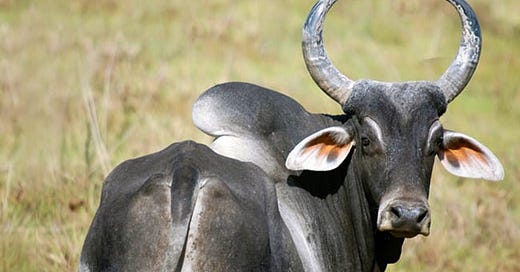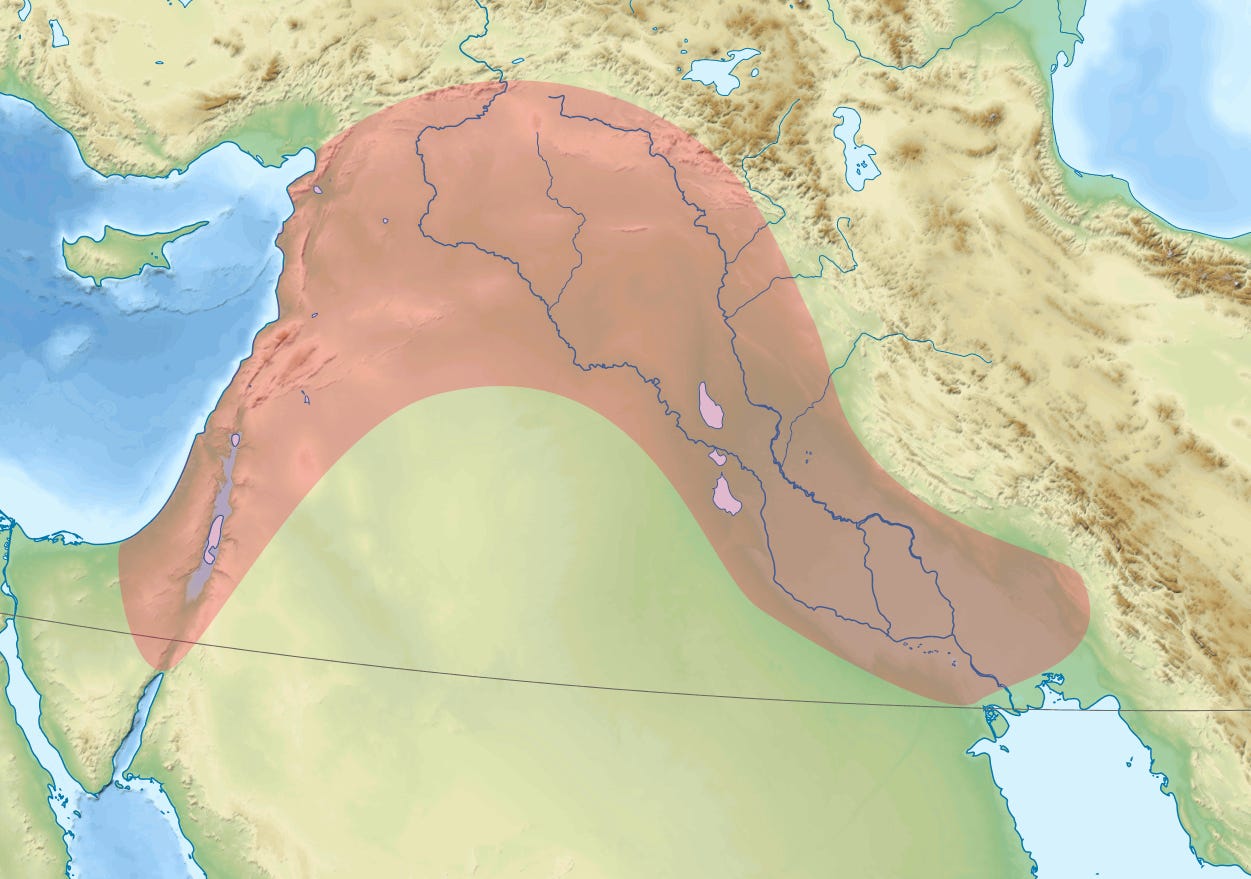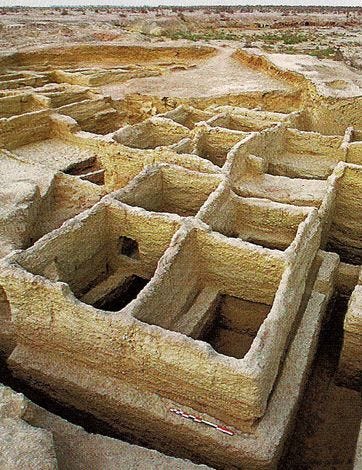Roughly one in every four people on the planet today resides in South Asia, the vast geographic region sandwiched between the Karakoram and Himalaya Mountains in the north and the Indian Ocean in the south. The first traces of toolmaking, and thus the presence of our ancestors or distant relatives, date back 1.5 million years. Homo erectus made its home in South Asia, and so too have modern humans for at least the past 50,000 years.
If we were to touch down in South Asia at the end of the Younger Dryas and the beginning of the Holocene around 12,000 years ago, however, we wouldn’t have seen many people. Archaeological traces of a human presence are few and far between at the end of the Pleistocene. Much of the region wasn’t particularly welcoming to people at that time; the Deccan Plateau, which makes up much of South Asia, would have been exceptionally arid. That is largely because the monsoon, which brings torrential but life-giving rain every summer, was either much weaker or altogether absent. The rain-fed seasonal rivers that make much of South Asia welcoming to people wouldn’t have flowed, leaving only the river valleys of the Indus and Ganges as particularly viable spots for people to live.
As the Pleistocene gave way to the Holocene, the monsoon began to take on something more like its current form. As was the case elsewhere in the world at that time, the number of people living in South Asia dramatically expanded with improving climatic conditions. Many of these new residents were the descendants of long-established hunter-gatherers. Some of them kept foraging; others experimented with new ways of life. But others were new arrivals who set themselves up on the edges of the Indus Valley, bringing with them an agricultural package first developed far to the west in the Fertile Crescent.
The Balochistan uplands of today’s Pakistan, where this farming package first appears in South Asia, is not especially close to the eastern fringes of the Fertile Crescent; it’s about 1400 miles from the foothills of the Zagros Mountains across the Iranian Plateau to the edge of the Indus Valley. That’s not exactly a casual stroll, particularly considering the aridity and roughness of the terrain in present-day Iran and Afghanistan. Despite the difficulty, these people seem to have made the journey, herding their sheep and goats and carrying their crops with them as they went.
If all we had to work with was the archaeological evidence, we might surmise that what moved east from the Fertile Crescent was the knowledge of farming, the domesticated animals, and the crops, rather than the people themselves. But genetics gives us detailed and fascinating insights into past population histories, and this evidence points strongly toward the movement of people.
Ancient DNA from the region of the Indus Valley points to two major ancestral groups. One of them, known to geneticists as “Ancient Ancestral South Indians,” was presumably made up of foragers whose ancestors had lived in South Asia for millennia. Today, that ancestral component reaches its highest proportions in India’s relatively isolated tribal groups. The other major component has affinities further to the west, with the early farmers who lived in the foothills of the Zagros Mountains on the eastern edge of the Fertile Crescent.
One of the fascinating insights that ancient DNA has provided is the knowledge that the people living in the Fertile Crescent at the dawn of agriculture belonged to several different and highly divergent groups. One, the Natufians, is the best known, but there were also foragers living to their north in Syria and Turkey who later expanded far to the west. A third group lived in the east, in the foothills of the Zagros Mountains. As their numbers rose, they migrated east into the Iranian Plateau and Central Asia. Initial analyses suggested that this third group also headed into South Asia, presumably bringing their domesticated animals and crops with them, but it’s actually a bit more complicated than that: The group ancestral to later residents of South Asia was related to, but not identical with, the group of Zagros farmers who later headed east. The straightforward scenario of expanding farmers migrating into South Asia wasn’t correct.
How should we explain this? There are essentially two options: First, that the group ancestral to later residents of South Asia had already lived there, and independently developed or adopted the Fertile Crescent farming package (which is what the authors of the paper that discovered this seem to think); second, that they lived in the Fertile Crescent, but we have yet to find and analyze one of their ancient genomes; or third, that they lived somewhere outside the Fertile Crescent, adopted farming, and then moved into South Asia.
Of these three options, the second and third are most probable. It seems unlikely that a group living 1400 miles to the east would have chosen precisely the same suite of domesticated plants and animals as their related brethren in the Fertile Crescent. It’s intriguing that a fourth distinct group, as yet unsampled by geneticists, might have been living in the Fertile Crescent alongside their relatives 10,000 years ago or more. But the most likely, in my opinion, is that the group ancestral to later South Asians was living somewhere between the Indus Valley and the Zagros, perhaps on the Iranian Plateau: close enough to adopt some pieces of the Fertile Crescent farming package, close enough to head a short distance east, through the Bolan Pass, and into South Asia.
The classic early farming site in South Asia is a place called Mehrgarh, in the uplands of Baluchistan on the fringes of the Indus Valley. It’s a remarkable place with almost 5,000 years of continuous occupation and in situ evolution: We can track the development of agriculture and a complex, highly organized society in a single site from around 7000 BC to 2500 or 2000 BC, when Mehrgarh was finally abandoned.
Wherever its inhabitants had come from in the distant past, Mehrgarh was the focal point for a sophisticated and eventually widespread society that adapted itself to conditions in South Asia. They brought goats and sheep from further west, along with wheat, barley, lentils, and legumes, but independently domesticated the local species of wild cattle. The zebu, with its distinctive hump, is one of the two main subspecies of domesticated cattle. It was probably domesticated in or around Mehrgarh:
The inhabitants of Mehrgarh and the other settlements in the region soon outgrew their surroundings in the Balochistan uplands. Starting around 4000 BC, they began to move east, into the Indus Valley. First slowly and then with increasing speed and sophistication, they built villages, then towns, and then pre-planned cities, with walls and grid patterns of streets.
Yet they were not alone in South Asia, nor were they the only ones engaged in farming. Further to the east, along the Ganges River, the indigenous foragers were also experimenting with plant cultivation. In fact, there were no fewer than five places in South Asia where we see evidence of independent plant domestication. Mung bean, urd bean, horsegram, several varieties of millet, and rice were all cultivated extensively. These crops had the benefit of being able to grow during the summer monsoon season. South Asia was actually home to multiple Neolithics of its own.
When combined with the introduced crops from the Fertile Crescent (which were grown during the winter), this package produced a full year of food production. Another variety of rice, which later hybridized with the native domesticated variety, was later introduced via Southeast Asia. All told, this was a remarkably flexible, diverse, and viable agricultural lifestyle, a crossroads that lay between multiple farming cultures.
Complex societies, craft specialization, trade, and cities were soon to follow. The Indus Valley Civilization, one of the least known and yet endlessly fascinating of the ancient world’s societies, occupied an enormous area stretching from the Arabian Sea to the foothills of the Himalayas. That’s what I’ll cover in next week’s newsletter.
If you’d like to learn more about ancient South Asia, check out today’s episode of Tides of History.
I wrote a book! It's called The Verge: Reformation, Renaissance, and Forty Years that Shook the World. The book comes out in July, but you can pre-order it here.







Geneticist Razib Khan links this post and comments on it:
https://www.brownpundits.com/2021/04/29/multiple-hearths-of-agriculture-in-ancient-south-asia/
A pleasure to read and learn more about ancient South Asia. We learned a lot of stuff about the Indus valley civilization growing up in India. This is very nice.